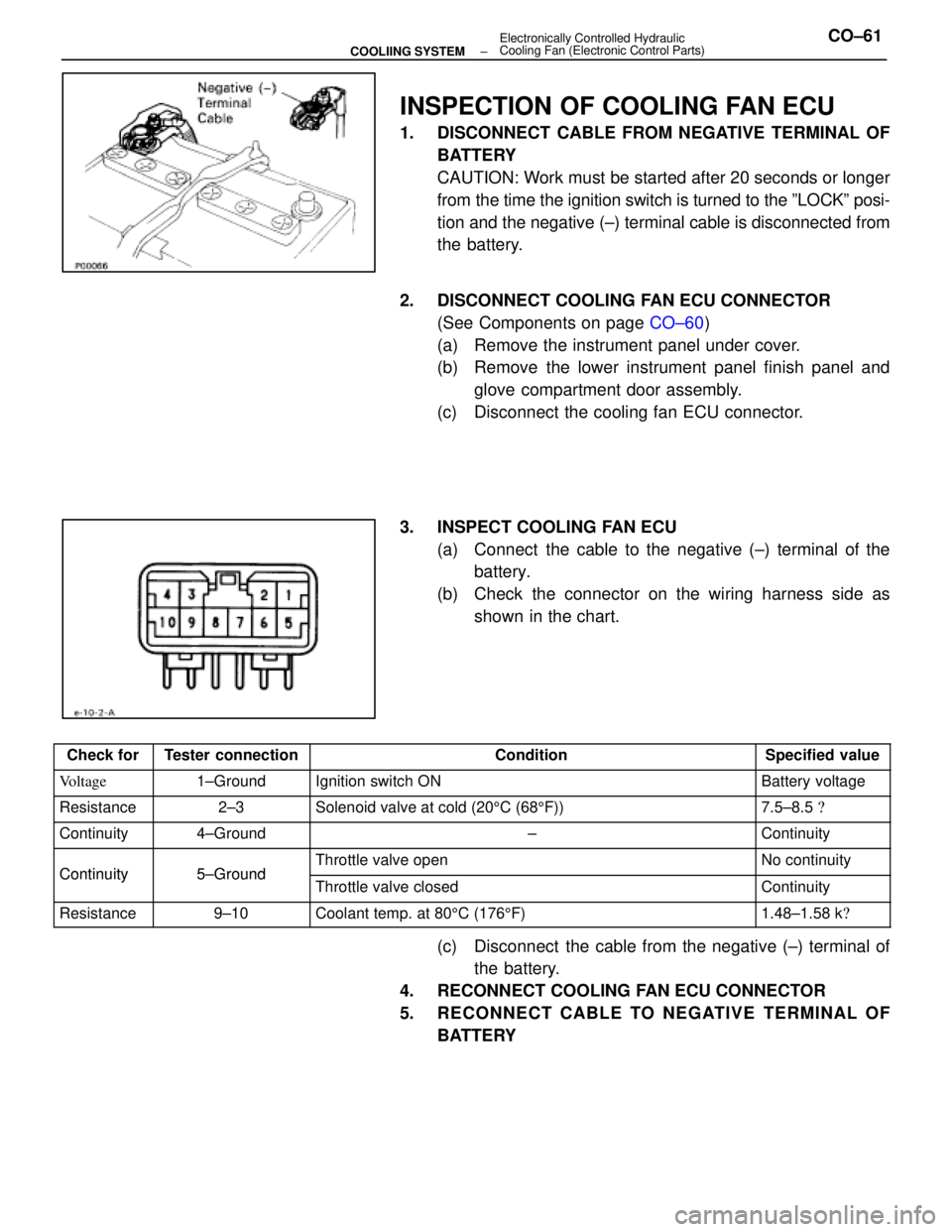Page 2847 of 4087

INSPECTION OF COOLING FAN ECU
1. DISCONNECT CABLE FROM NEGATIVE TERMINAL OFBATTERY
CAUTION: Work must be started after 20 seconds or longer
from the time the ignition switch is turned to the ºLOCKº posi-
tion and the negative (±) terminal cable is disconnected from
the battery.
2. DISCONNECT COOLING FAN ECU CONNECTOR (See Components on page CO±60)
(a) Remove the instrument panel under cover.
(b) Remove the lower instrument panel finish panel and glove compartment door assembly.
(c) Disconnect the cooling fan ECU connector.
3. INSPECT COOLING FAN ECU (a) Connect the cable to the negative (±) terminal of thebattery.
(b) Check the connector on the wiring harness side as shown in the chart.
Check forTester connectionConditionSpecified value
Voltage1±GroundIgnition switch ONBattery voltage
Resistance2±3Solenoid valve at cold (20 5C (68 5F))7.5±8.5 �
Continuity4±Ground±Continuity
Continuity5±GroundThrottle valve openNo continuityContinuity5±GroundThrottle valve closedContinuity
Resistance9±10Coolant temp. at 80 5C (176 5F)1.48±1.58 k �
(c) Disconnect the cable from the negative (±) terminal of
the battery.
4. RECONNECT COOLING FAN ECU CONNECTOR
5. RECONNECT CABLE TO NEGATIVE TERMINAL OF BATTERY
±
COOLIING SYSTEM Electronically Controlled Hydraulic
Cooling Fan (Electronic Control Parts)CO±61
WhereEverybodyKnowsYourName
Page 2957 of 4087

OKNG
NGOK
NGOK
OKNG
INSPECTION PROCEDURE
1Check operation of brake warning light.
Check that the brake warning light in the instrument panel comes on when the \
parking brake is opera-
tion with the engine running, and the light goes off when the parking brake is not operating.C
Check brake warning light circuit.
2Input signal check.
C
OK
1. See input signal check.
2. Check the indicator light when the parking brake isoperating.
The indicator light goes off when the parking brake
is operating.
Proceed to next circuit inspection shown on matrix
chart.
3Check voltage between terminal PKB of tilt & telescopic ECU connector and bod\
y ground.
C
OK
PRemove tilt & telescopic ECU with connectors still con-
nected.
1. Turn ignition switch ON.
2. Measure voltage between terminal PKB of tilt & telescopic ECU connector and body ground, when
the parking brake lever is operating.
Proceed to next circuit inspection shown on matrix
chart.
4Check for open in harness and connector between tilt & telescopic ECU and brak\
e warning light
(See page IN±33).
.
Repair or replace harness or connector
Check and replace tilt & telescopic ECU.
±
STEERING STEERING COLUMNSR±97
WhereEverybodyKnowsYourName
Page 3080 of 4087
LOCATION OF CONNECTORS IN INSTRUMENT PANEL
SR±58±
STEERING STEERING COLUMN
WhereEverybodyKnowsYourName
Page 3118 of 4087

When the vehicle is involved in a frontal collision in the
hatched area (Fig. 1) and the shock is larger than a predeter-
mined level, the SRS is activated automatically. A safing sen-
sor is designed to go on at a smaller deceleration rate than
the front and center airbag sensors. As illustrated in Fig. 2,
ignition is caused when current flows to the squib, which hap-
pens when a safing sensor and a front airbag sensor and/or
the center airbag sensor go on simultaneously. When a de-
celeration force acts on the sensors, two squibs in the driver
airbag and front passenger airbag ignite and generate gas.
The gas discharging into the driver and front passenger air-
bags rapidly increases the pressure inside the bags breaking
open the steering wheel pad and instrument panel door.
Bag inflation then ends, and the bags deflate as the gas is
discharged through discharge holes at the bag's rear or side.
RS±14±
SUPPLEMENTAL RESTRAINT SYSTEM OPERATION
WhereEverybodyKnowsYourName
Page 3132 of 4087

FRONT PASSENGER AIRBAG
ASSEMBLY
INSPECTION ITEMS
RS042±01
1. VEHICLES NOT INVOLVED IN A COLLISION
(a) Perform a diagnostic system check.(See page RS±59)
(b) Perform a visual check which includes the following items
with the front passenger airbag assembly installed in the
vehicle.
wCheck for cuts, minute cracks or marked discoloration
of the front passenger airbag door.
2. VEHICLE INVOLVED IN A COLLISION IF THE AIRBAG IS NOT DEPLOYED
(a) Perform a diagnostic system check. (See page RS±59)
(b) Perform a visual check which includes the following items
with the airbag assembly removed from the vehicle.
wCheck for cuts, cracks in, or marked discoloration of the
front passenger airbag door.
w Check for cuts, cracks in, or chipping of connectors and
wire harness.
w Check for deformation of the instrument panel and
instrument panel reinforcement.
HINT:
w If the instrument panel and instrument panel
reinforcement is deformed, never repair it. Always
replace it with a new one.
w There should be no interference between the
instrument panel and front passenger airbag door. The
clearance should be uniform all the way around when
the new airbag assembly is installed on the instrument
panel.
CAUTION: For replacement of the airbag assembly, see
page RS±30 , ªFRONT PASSENGER AIRBAG ASSEMBLY
REMOVAL AND INSTALLATIONº and be sure to follow
the correct procedure.
RS±28
±
SUPPLEMENTAL RESTRAINT SYSTEM FRONT PASSENGER AIRBAG ASSEMBLY
WhereEverybodyKnowsYourName
Page 3133 of 4087

IF THE AIRBAG IS DEPLOYED
(a) Perform a diagnostic system check. (See page RS±59)
(b) Perform a visusal check which includes the following items
with the airbag assembly removed from vehicle.
wCheck for deformation of the instrument panel and
instrument panel reinforcement.
w Check for damage to the connector and wire harness.
HINT:
w If the instrument panel and instrument panel
reinforcement is deformed, never repair it. Always
replace it with a new one.
w There should be no interference between the
instrument panel and front passenger airbag door. The
clearance should be uniform all the way around when
the new airbag assembly is installed on the instrument
panel.
REPLACEMENT REQUIREMENTS
RS01M±06
In the following case, replace the front passenger airbag as-
sembly, instrument panel, instrument panel reinforcement.
CAUTION: For replacement of the front passenger airbag
assembly, see page RS±30, ªFRONT PASSENGER AIR-
BAG ASSEMBLY REMOVE AND INSTALLATIONº and be
sure to follow the correct procedure.
w If the airbag has been deployed.
w If the front passenger airbag assembly has been found
to be faulty in troubleshooting.
w If the front passenger airbag assembly or instrument
panel reinforcement has been found to be faulty during
the check in item 1±(b) or 2±(b).
w If the front passenger airbag assembly has been
dropped.
±
SUPPLEMENTAL RESTRAINT SYSTEM FRONT PASSENGER AIRBAG ASSEMBLYRS±29
WhereEverybodyKnowsYourName
Page 3135 of 4087
1. DISCONNECT NEGATIVE (±) TERMINAL CABLE FROMBATTERY
CAUTION: Work must be started after 90 second from the
time the ignition switch is turned to the LOCK position
and the negative (±) terminal cable is disconnected from
the battery (See page RS±2).
2. REMOVE NO. 2 INSTRUMENT PANEL UNDER COVER
(a) Using a clip remover, remove 2 clips.
(b) Remove the under cover.
3. DISCONNECT AIRBAG CONNECTER
(a) Remove the glove compartment door finish plate inside the glove compartment.
NOTICE: When handling the airbag connector, take care
not to damage the airbag wire harness.
(b) Pull up the connector.
(c) Disconnect the airbag connector.
4. REMOVE GLOVE COMPARTMENT ASSEMBLY
(a) Remove the 2 console box hole covers.
(b) Remove the 4 screws and clip.
(c) Remove the glove compartment assembly.
±
SUPPLEMENTAL RESTRAINT SYSTEM FRONT PASSENGER AIRBAG ASSEMBLYRS±31
WhereEverybodyKnowsYourName
Page 3136 of 4087

5. REMOVE GLOVE COMPARTMENT DOOR LOCKMOUNTING BRACKET
Remove the 2 screws, disconnect the door lock mounting
bracket.
(a) Remove the 3 screws, 2 nuts and bolt.
6. REMOVE FRONT PASSENGER AIRBAG ASSEMBLY
(b) Pull out the front pass enger airbag assembly from the
instrument panel.
NOTICE: When removing the front passenger airbag as-
sembly, take care not to pull the airbag wire harness.
CAUTION:
w When storing the front passenger airbag assembly, keep
the upper surface of the front passenger airbag assembly
facing upward.
w Never disassemble the front passenger airbag assembly.
7. INSTALL FRONT PASSENGER AIRBAG ASSEMBLY
(a) Install and torque the 2 nuts and the bolt.
Torque: 21 N Vm (210 kgf Vcm, 15 ft Vlbf)
(b) Install the 3 screws.
NOTICE:
w Make sure the front passenger airbag assembly is
installed to the specified torque.
w If the front passenger airbag assembly has been
dropped, or there are cracks, dents or other defects in the
case or connector, replace the front passenger airbag
assembly with a new one.
w When installing the front passenger airbag assembly,
take care that the wiring do not interfere with other parts
and are not pinched between other parts.
RS±32±
SUPPLEMENTAL RESTRAINT SYSTEM FRONT PASSENGER AIRBAG ASSEMBLY
WhereEverybodyKnowsYourName